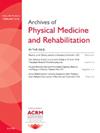Executive Function (Anticipation) Differences Between Soccer Players with and Without a History of Traumatic Brain Injury 4360
IF 3.6
2区 医学
Q1 REHABILITATION
Archives of physical medicine and rehabilitation
Pub Date : 2025-04-01
DOI:10.1016/j.apmr.2025.01.013
引用次数: 0
Abstract
Objectives
To investigate a soccer player's ability to initiate judgment through postural-cues, implement perception through cue-detection, and perceive an oncoming action through cue-utilization.
Design
Repeated-measures design, over the span of one 60-minute-session.
Setting
Remotely.
Participants
A total of 57 participants: 17 women, 40 men. Years of soccer experience: 13, 1-9 years; 44, 10+ years; athletic level: 15, high school; 37, collegiate; and 5, semiprofessional.
Interventions
Executive function assessments: 1. working memory: picture matching, 2. attentional control: self-report survey, 3. cognitive flexibility: task switching, and 4. anticipation: Brixton spatial anticipation test (BSAT) and temporal occlusion.
Main Outcome Measures
(1) Planning, (2) self-monitoring, (3) execution, and (4) pattern detection and athletic cues.
Results
(1) Attentional control: the multivariate analysis of variance revealed significant effect of years of soccer experience on 2 out of 5 attentional control questions (alternating between 2 task; easily distracted while reading or studying if other people are talking in same room); F(2,54)=3.755, Wilks λ=0.878, P=.030. (2) Anticipation: pattern detection (BSAT)—(i) The linear regression analysis performed on the second BSAT scores indicated one predictor explained 9.3% of the variance (R2=0.120, F[2,53]=2.406, P=.078). The significant predictor was soccer athletic level (β=−0.126, P=.045). (ii) The linear regression analysis performed on the BSAT Average scores indicated one predictor explained 8.9% of the variance (R2=0.093, F[2,53]=1.805, P=.157). The significant predictor was soccer athletic level (β=−0.09, P=.034). (3) Anticipation: athletic cues (temporal occlusion)—(i) The linear regression analysis performed on the temporal occlusion overall scores indicated one predictor explained 10.8% of the variance (R2=0.135, F[2,53]=2.746, P=.052). The significant predictor was gender (β=−0.078, P=.017). (ii) The linear regression analysis performed on the Temporal Occlusion Task One scores indicated one predictor explained 8% of the variance (R2=0.081, F[2,53]=1.554, P=.211). The significant predictor was gender (β=−0.097, P=.051).
Conclusions
The results of this study concluded that when traumatic brain injury-history, gender, and soccer athletic level are factors, athletes with a soccer level of collegiate and semiprofessional had decrements related to pattern detection anticipation; meaning athletes at higher levels had lower average scores on the BSAT. Additionally, women athletes showed more anticipation decrements related to athletic cues, especially those that are reliant on the initiation of judgment. Overall undiagnosed traumatic brain injuries and limited understanding on how to approach rehabilitation to mitigate EF decrements, continue to impede individual autonomy amongst athletes.
Disclosures
none.
求助全文
约1分钟内获得全文
求助全文
来源期刊
CiteScore
6.20
自引率
4.70%
发文量
495
审稿时长
38 days
期刊介绍:
The Archives of Physical Medicine and Rehabilitation publishes original, peer-reviewed research and clinical reports on important trends and developments in physical medicine and rehabilitation and related fields. This international journal brings researchers and clinicians authoritative information on the therapeutic utilization of physical, behavioral and pharmaceutical agents in providing comprehensive care for individuals with chronic illness and disabilities.
Archives began publication in 1920, publishes monthly, and is the official journal of the American Congress of Rehabilitation Medicine. Its papers are cited more often than any other rehabilitation journal.

 求助内容:
求助内容: 应助结果提醒方式:
应助结果提醒方式:


